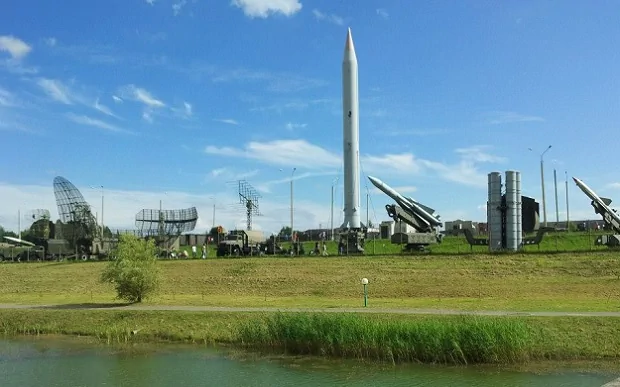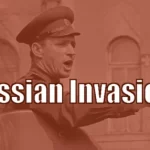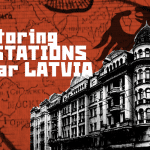by Māris Goldmanis on January 24th, 2015

For years “UVB-76 The Buzzer” also known as UZB-76, MDZhB, or S28 that constantly transmits on 4625 kHz has been associated with the “Dead Hand”. Most of the speculations about the connections between the Buzzer and the Soviet Cold War era nuclear weapon connection system are based on myths. However, every myth has certain truth in it. The Buzzer, Pip and Squeaky Wheel have the Cold War origin and association with the reforms within the Soviet military and its communications and defense system. Also the standard Buzzer message codenames such as BROMAL, NAIMINA ect. spelled in Russian phonetics were known already from the Cuban Missile Crisis and even before. They are called monolyth’s. This article describes the story about the use of the monolyth message BRONTOZAUR (БРОНТОЗАВР) and the origins of the Dead Hand (also called the Perimeter) system and its possible connections between the Buzzer and other radio networks.
The story about the BRONTOZAUR message is told by Colonel of the Strategic missile forces Valery Yarynich. In 1984 he was assigned by the new Soviet leader Yuri Andropov as the Chief Deputy of the Chief Authority of the Rocket weapon command. Yarynich was an expert in communications – radio, satellite and cable. His past experience in the Cuban Missile Crisis lead him to improve the communication issues within the nuclear forces.
At the start of the Cold War the soviet nuclear war communications were very primitive. The Soviets initiated the rockets arms race by launching the first space satellite on 1957. In 1959 the Soviets built the R-7 – the world’s first intercontinental Ballistic Missile. The heavy liquid oxygen missiles were placed on the regular guard duty. The soviet leader Nikita Khrushchev was so excited about them that he boasted to the Americans that soviets builds rockets like sausages. In reality he had only 27 R-7 rockets, while the US and NATO had twice the numbers of Atlas and Titan type rockets. Also the medium range rockets placed in West Germany and Turkey. However, the Khrushchev’s threats that he “will bury” the allies made them to produce even more rockets like the Minuteman. The US political and military leadership did not know or ignored the fact that R-7 rockets did not use the underground missile silos meaning if the Soviets launch the nuclear attack first they would certainly receive a counter attack, but if allies attack first – the soviets could not answer in return. Such situations lead the soviets and allies escalate the missile crisis in Cuba where we return again to our hero – Valery Yarynich.
After graduating the Leningrad Military communications school in 1959 he was appointed to serve at the Jur’e Rocket Base near Kirov city. As stated him in his book “C3: Nuclear Command, Control, Cooperation” the orders to the rocket base commanders were given by radio or cable. The messages used coded word system called the “Monolyth”. In a event of emergency the commander opened the special envelope kept in safe at the command point just in case. Yarynich remembers that in the training drill in the definite moment the officer in duty could not open the envelope fast enough because of the stressful shaking hands. It was decided not use scissors when opening the vital envelope. Instead a zipper was used so the operator could open the envelope quickly. The whole monolyth system was unreliable, worse than that the monlyth order could not be reversed nor canceled.
In October 1962 Yarynich was sent to the rocket division in the Nizhny Tagila 1380 km from Moscow. It was the height of the Cuban Missile Crisis. Then a monolyth message reached the base it was BRONTOZAUR (БРОНТОЗАВР). The meaning of this message was to switch the command system from standby to the full combat alert. As Yarynich picked up the teletype message from the young female operator he was in shock “Dear God! BRONTOZAUR!” It was the first time when they received the message and it meant that the package must be opened. The package contained new callsings and frequencies in case of the nuclear war. Yarynich wrote that it was unreasonable to change the callsings and frequencies in such an event leading to chaos in communications, but such was the procedure. The new information then had to be forwarded to all other rocket bases. The rockets at Nizhny Tagila were not yet fueled and the stress and horror of all the communications staff – officers, conscripts and the female telephone operators were unforgettable. The nuclear war did not happen, but the issue about handling the rocket force communications remained.
The first attempt of making the automatic rocket system was made in 1967. The system was called “Signal” that could issue 30 pre-made orders from the staff headquarters to the rocket units. For instance the order to increase combat readiness. In comparison to paper packets and envelopes it was a huge step forward. However, the Signal could not operate the rockets themselves. Orders were received by military personnel who then had to operate the rocket complexes. So in 1970’s a new version “Signal-M” was issued that allowed to issue the orders from the highest to the lowest ranks of the soviet military. It was the time when the new gigantic RC-20 ICBM’s were released. Also the first Buzzer activities were sighted on this same time. Meaning the station on 4625 kHz was part of the new military communications system to universalize the communications between all ranks and branches. The Monolyth codeword system remained.
The new RC-20 rockets were capable of launching them by the distant controls by the push of the button. However, the Signal M had is shortcomings. After the event when the alarm system had suffered a failure and issued all to increase the combat readiness that in theory allowed to press the launch button. The officers did not believe the alarm and instead of calling all troops out of barracks they rushed to determine if the order was not false. Later the Signal M was upgraded to “Signal A” on 1985 that was computerized allowing to send new missile route plans to the silos in 52 seconds. It was also to avoid time delay caused by confusion of the officers receiving such an order to get the work more faster and operative, but as every atomized system it was not safe.
In 1984 Yarynichin came to the conclusion that the idea of an ultra-fast launching nuclear weapon had come to a dead end. Both sides could not gain the superiority; they could just speed up the process of making the decisions. In the case of a nuclear blast especially when directed towards to staff headquarters and military bases could greatly disrupt the communications networks. The radio, cables, and satellite signals in such a case could simply be taken off air. In fear of an Electro-Magnetic Pulse caused by the multitude of blasts causing a total blackout, the soviets looked for other ways to operate the rocket forces.
The new upgrades included building a massive nuclear war bunker in the Uralian mountains codnamed “Grot”( грот) that was built north of Sverdlovsk city. In case of nuclear war the command could take shelter there and continue to operate the nuclear weapons. It was chosen to build the bunker in the granite mountain because granite could allow the radio signal to the underground. Another idea was to create a command rocket containing electronics capable of directly launching an order to all land based rockets. However, it could take half an hour for command rocket to fulfill its duty, by that time all the ICBM’s could be already destroyed. Despite that the project for such a system was started by the constructors bureau “Juzhnoe” in Dnipropetrovsk, Ukraine in 1974. Both the bunker and the command rockets lead to another major project – The Perimeter or the Dead Hand.
In the middle of 1980’s, soviets were scared by the anti-communist rhetoric of the US President Ronald Reagan. Some of the political and military leadership suspected that Reagan wants to launch an attack against the Soviet Union. Soviets could not successfully launch a preemptive strike as the all allied rockets could not be destroyed. Another solution that was in use was to relay on the satellite and early warning radars to discover the missile launch and order the counter launch accordingly. However, the system was fragile to errors such as confusing flying flocks of gooses as enemy rockets. The third variant was only to launch the counter attack if the enemy missile launch has been fully confirmed. Soviets in the seventies had finally reached the equality with the allies in terms of nuclear weapons. But what if the ones to launch a revenge attack does not stay alive? How will they act and what will happen to them was not answerable question. For instance the old ill soviet leader Konstantin Chernenko would die before ordering the launch? So an idea for the automatic launch system was made.
Constructors created a switch to allow the irrational Chernenko not to make decision on the revenge attack. Even if the old dying man would want to press button himself, but die in the nuclear attack on Kremlin he would be sure that his country would strike back after all. The switch then forwarded the responsibility to a military officer; also in case of false alarm the old leader would not be bothered. This system was called the “Perimeter” and was in the making for 10 years, but that was not enough in case of the deaths of all military leadership the computers should memorize the order of the nuclear revenge strikes and launch the rockets without a human order. However, in the end the constructors gave up the idea of relaying the fate of mankind to computers. Note that the soviet computer system was just as primitive and error capable as all other soviet communications systems. Such a project was also extremely difficult to realize based on the circumstances.
The “Perimeter” system was however realized. In the first moments of the nuclear crisis, the order of the attack could reach the general headquarters or the “Grot” bunker. The bunkers nicknamed “balls” (шариках) were covered in concrete and dug in deep in underground. Usually they were served by low rank officers. In case of war their task was to first to check if the Perimeter system was activated or if theKremlin has issued the order. If all contacts with the leadership both political and military is lost – then they determined there was a nuclear blasts using special equipment. If so then the officers in the “balls” should give the order of a nuclear attack. Still the theoretical question remained – without the artificial command system, will the officers in the “balls” will not double think this order? If one part of the Earth is destroyed why destroy the other? And if the country is no more – no one would punish them for not issuing the order. However, they were kept in these “balls” without any communications to the outside world trained to fulfill orders automatically without the question and if they would be the last ones to avenge their homeland.
The Perimeter system was tested on November 13th, 1984. The commanding point was from the Lenningrad constructor’s bureau. On the low frequency transceiver the signal was sent, then it was received at the command rocket at the Kapustin Yar test site near river Volga. The rocket was launched towards Kazakhstan. In its flight the rocket gave the “Launch” order . In some parts the signal was stronger in others not. The testing nuclear missile that received the order located in Kazakhstan was ready for launch. However, the soviet officials delayed the launch because they thought that it was being observed by the US spy satellites. Soon after, the rocket was allowed to launch and it reached its target at Kamchatka. In 1985 the Perimeter system was placed in order. However, in 1985 Chernenko had passed away and the new, more able leader Mikhail Gorbachev started a path to end the Cold War.
What do we learn from this long story? First that the buzzer “monolyth” messages were used as early as 1962 and probably before that. The codeword in this case BRONTOZAUR had a special purpose just as other such messages sent also on 3756 khz and 3828 kHz etc. Second most important – the Perimeter and Dead Hand was made to avoid the radio communications for operating the nuclear forces. For the understandable reasons of unreliability of such communications in case of nuclear war. The very point of the “Perimeter” was to avoid the inability to strike back in case of loss of the military or the political command. The Dead Hand was an idea that computers could be programmed to order the rocket launch if there was no other human to do it. Such an idea, as crazy as its sounds, was not created because it was technically impossible to realize or to morally create one, and it had nothing to do with the radio signals on shortwave from the start.
Also as mentioned the upgrades in the communications systems that took part in 70’s-80’s possibly meant that the appearance of Buzzer on 4625 kHz and Pip on 3756 kHz was part of attempts to create a regular daily communication and command system. Not just for the rocket forces, but also for regular forces. Does the Perimeter system work until this day? Possibly, as the conventional Russian armed forces have not changed much, then neither has their nuclear forces system. We can just hope that there will not be time when a young Russian officer sitting in a concrete “ball” would not have to decide the fate of the mankind when his commanding officers and president had already lost their responsibility.
Sources
1.) Valery Yarynich, the man who told of the Soviets’ doomsday machine – Washington Post
2.) Suvorovs, Viktors. (2012) KuzjasMāte. Dižās Desmitgades Hronika. Rīga. Dienas Grāmata. (Viktor Suvorov. The Devils Mother. The Chonicle of the Great Decade), p. 191-194
3.) Хоффман, Дэвид. (2011) Мертвая рука. Неизвестная история холодной войны и ее опасное наследие. (The Dead Hand: The Untold Story of the Cold War Arms Race and Its Dangerous Legacy, 2010 by David Hoffman) p.195-209.




